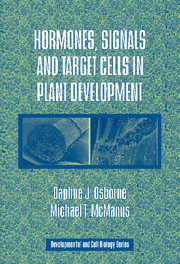Book contents
- Frontmatter
- Contents
- Preface
- 1 Introduction
- 2 Hormones and Signals: Identification and Description of Signalling Molecules
- 3 Cell-to-Cell Signalling: Short and Long Distance
- 4 Population Diversity of Cell Types and Target Identification in Higher Plants
- 5 Flexibility of Cell Types and the Target Cell Status
- 6 Terminally Committed Cell Types and the Target Status
- 7 The Mechanisms of Target Cell Perception and Response to Specific Signals
- 8 Hormone Action and the Relief of Repression
- 9 The Phenomenon of Hormonal Cross-Talk
- References
- Index
4 - Population Diversity of Cell Types and Target Identification in Higher Plants
Published online by Cambridge University Press: 06 August 2009
- Frontmatter
- Contents
- Preface
- 1 Introduction
- 2 Hormones and Signals: Identification and Description of Signalling Molecules
- 3 Cell-to-Cell Signalling: Short and Long Distance
- 4 Population Diversity of Cell Types and Target Identification in Higher Plants
- 5 Flexibility of Cell Types and the Target Cell Status
- 6 Terminally Committed Cell Types and the Target Status
- 7 The Mechanisms of Target Cell Perception and Response to Specific Signals
- 8 Hormone Action and the Relief of Repression
- 9 The Phenomenon of Hormonal Cross-Talk
- References
- Index
Summary
Plants are remarkable in that during evolution from the single cell to the multicell state they developed centres of cell division, the meristems, as the principal repositories of all genetic information. In essence, whether it be the single apical cell of a liverwort or the multicellular dome of tissue of the higher plant, the meristem holds the blueprint of the species. It is only from the divisions of their meristematic cells that the plant body can continuously enlarge and reproduce. Whereas an embryo generates polar identities and a meristematic initiation from the two opposing ends of the zygotic cell, whole plants do not have a restriction to two meristems and they develop unlimited numbers of new primordia as the body of the plant continues to increase in size and cell number.
Anatomists, biochemists, molecular biologists and developmental botanists each see the same plant from different viewpoints. The anatomist studies the structural and visible characters of cells and tissues and describes them accordingly. The biochemist homes in on the functional processes of metabolic control and enzymatic activity attributable to specific plant parts – photosynthetic activity in leaves, for example. The molecular biologist seeks the genetic control of biochemical processes and is particularly attracted to the performance of mutant plants with abnormal behaviour, using them to probe the genetic control of the normal.
- Type
- Chapter
- Information
- Hormones, Signals and Target Cells in Plant Development , pp. 76 - 97Publisher: Cambridge University PressPrint publication year: 2005



